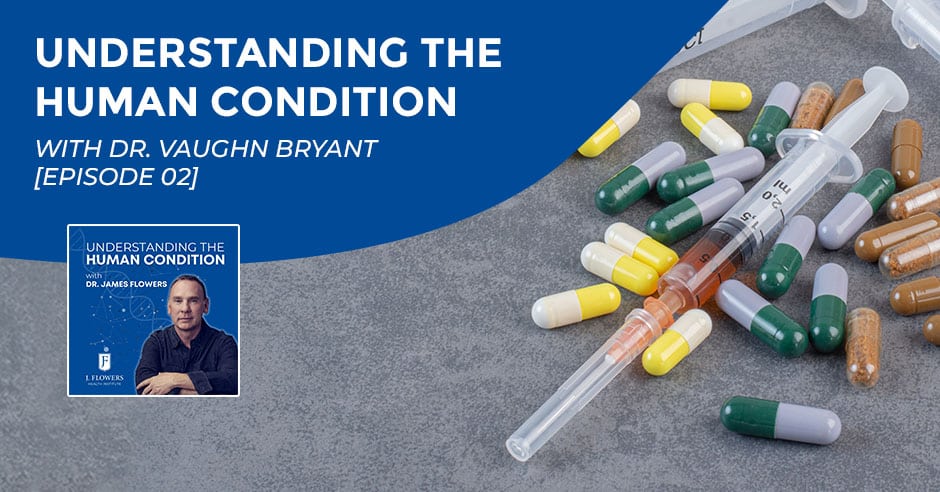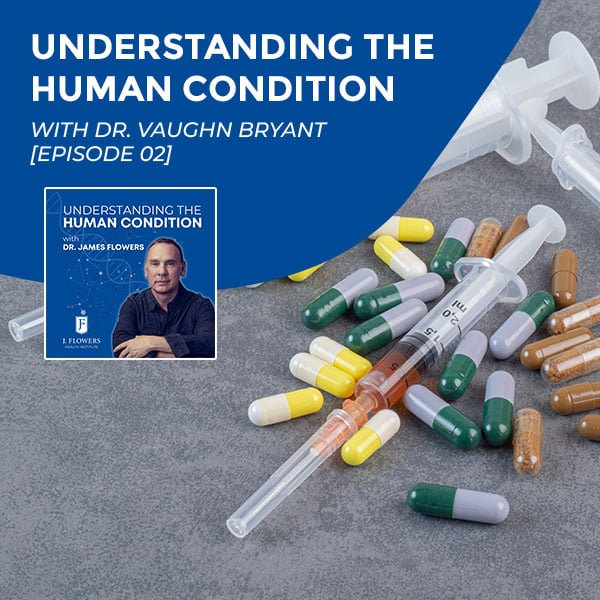
Dr. Vaughn Bryant has been a mental healthcare provider, trainer and educator for over 30 years. He brings a wealth of experience and expertise in the evaluation and treatment of the full spectrum of psychological, behavioral and relational problems to the J. Flowers Health Institute. Dr. Bryant has a very particular set of skills that he has developed over a long career that has equipped him to identify the root cause of dysfunction and create a plan of care that moves individuals and families in the direction of recovery and wellness.
—
Listen to the podcast here
Understanding And Destigmatizing Substance Use Disorder With Dr. Vaughn Bryant
This is episode two with Dr. Bryant.
I am glad to be here.
We brought a guest, Dr. Vaughn Bryant.
Welcome, Dr. Bryant. Thank you for coming, and thank you for being a part of this. I’m so happy to have Dr. Bryant as a part of J. Flowers Health Institute. I’ve known Dr. Bryant for quite a few years and we’ll talk about that in a minute. I wanted to tell everybody a little bit about Dr. Bryant and here is a short bio.
Dr. Bryant has been a mental health care provider, trainer, and educator for over 30 years. He brings a wealth of experience and expertise in the evaluation and treatment of the full spectrum of psychological, behavioral and relational problems to the J. Flowers Health Institute. Dr. Bryant is licensed as a Marriage and Family Therapist, Professional Counselor, and also a Chemical Dependency Counselor.
His career has included three decades of clinical service, clinical education, and executive management experience in large healthcare corporation settings, substance use disorder, treatment centers, a large Military hospital, clinical pastoral care, and as a professor in higher education. Dr. Bryant has developed a very particular set of skills over a long career. He has equipped himself to identify the root causes of dysfunction and create a plan of care that moves individuals and families in the direction of recovery and wellness. Welcome, Dr. Bryant.
Welcome.
Thank you.
How Dr. Bryant And Dr. Flowers Met
For both of you, Dr. Bryant and Dr. Flowers, can you share with the audience how you met, your journey to getting together, and how that all happened?
You bet. Dr. Bryant, I’ll let you lead the way on that.
I’ll start with that. I was working at a substance use disorder treatment center here in Houston. This was several years ago. We were doing a really good job of treating substance use disorder, but there was something missing. There was the emergence of the opioid epidemic. The executives at the hospital there knew that it was time to do something about this, to offer an alternative to chronic management of pain with opiates. That’s where Dr. Flowers showed up.
Dr. Flowers came in and developed an opioid pain recovery program. It was a phenomenal success. We saw patients come in who had been taking opioids for decades to manage some kind of pain. When they come into the program, they would not only get detoxed off the opiates but also receive physical therapy and experience some of the tools like mindfulness. They learned how to reorganize their thoughts and their reaction to their body. We saw people that came in wheelchairs leave walking 30 days later. That’s how I met Dr. Flowers.
That’s exactly how we met. It was and still is an amazing program here in Houston. Speaking of coming in on a wheelchair, there was a woman from San Antonio, Texas, who started out with a very small two-millimeter tumor in her cervical spine. She was seen as a patient at MD Anderson and they removed the tumor. When they removed the tumor, they clipped a nerve in the cervical spine, which is very painful and indeed can become a chronic painful condition.
Since she was at MD Anderson as a cancer patient, when they removed the tumor and cut the nerve, they decided to put her on an opiate right away for acute pain. It was nonterminal cancer, so I disagree with putting her on an opiate right away. Nonetheless, they did. Over time, she became very addicted to OxyContin, oxycodone, and morphine. It continued throughout the years.
It was a very successful business family in San Antonio. It was a husband and wife. They had three grandchildren. Over a three-year period, this woman went from no pain to living a life of pain, unable to lift her grandchildren and unable to function. They lost their business. It was a multimillion-dollar a year profitable business. She continued to take something called Actiq. Actiq is somewhat like a hydromorphone medication. It’s filled with sugar. You suck on it like a lollipop.
I remember this case, the lollipops.
We called it the lollipop case. She came in and met with me. She ended up staying in the program for 60 days. She was in a wheelchair when she came in. Her teeth had rotted out because of all the sugar and the lollipop, sucking on it 24 hours a day. Her husband was spending $105,000 a month out of his pocket on her medication because insurance refused to pay for it and said, “You don’t meet the criteria.” He was spending $100,000 a month on medication.
She spent 60 days in the program. We did mindfulness, meditation, yoga, tai chi, cognitive behavioral therapy, and lots of physical therapy. When she left 60 days later, she was lightly jogging about one and a half to two miles a day and taking zero opiate medications at all. That was several years ago. I happen to know, because sometimes patients will keep in touch with me, that she continues to be pain-free and is living an amazing life. They’ve rebuilt their company and have a great life together. That’s how Dr. Bryant and I met. I was thrilled that Dr. Bryant decided to join us at the J. Flowers Health Institute. It has been great having you with us. Dr. Bryant, would you explain to the audience? It’d be great to start with. Why don’t you tell us what a substance use disorder is as a diagnostic term?
Substance Use Disorder
Substance use disorder is the term we use in the mental healthcare industry to refer to a problematic relationship with an intoxicating substance. Everybody knows what addiction is. We have all these images in the movies and on TV shows of addiction or the addict. The problem is that it only represents about 5% or maybe 10% of people who have a diagnosable substance use disorder. What happens then is the general population, when they think of addiction or substance use disorder, they think of that caricature that’s the extreme case. In reality, substance use disorder is diagnosed on a spectrum. It’s a progressive condition that gets worse over time.

One of the things that really inspires me in my work is I want to help people experience wellness in their lives. It is a much better prognosis when we can work with someone in the earlier stages of the progression of the disease as well as work with them when they’re in a less severe case. I know people refer to substance use disorder as addiction. Everyone knows what you’re talking about. In reality, people have these symptoms or indicators in graduating degrees that manifest in their lives. They can get help really early on. Within about three months, they can resolve this problem.
They can go into remission.
That’s right.
Can you talk a little bit about that spectrum of disorders?
Sure. There are eleven indicators that make up a substance use disorder, regardless of whatever the drug is. Of those eleven symptoms, the first one is tolerance, which takes more of the substance to get the effect. Withdrawal is another symptom where people experience the opposite of what intoxication does. Another indicator of a substance use disorder is people end up taking more than they had intended. We see this, particularly with prescriptions where people run out.
That’s exactly what I was thinking of in the chronic pain world with opiates. Opiates were intended for short-term use, and they often become chronic. When we use opiates over time, we develop something called hyperalgesia, which means we have an increased tolerance for that particular medication. It takes more medication to achieve the same response. In other words, lower pain.
People sometimes double and triple their use of OxyContin because their tolerance for that medication has gone up and their tolerance for pain has gone down. Hyperalgesia is an increased sense of sensitivity to pain, so it takes more medication. You’re exactly right. They then go into a withdrawal symptom and begin to have sweats, chills, shakes, tremors, and things like that. Go ahead.
Those first three symptoms are what we refer to as the physiological symptoms, which really clearly show the neurological and biological aspects of a substance use disorder. There’s a group of symptoms that have more to do with their social and occupational functioning, like impairment in work, impairment in relationships, and impairment in general motivation for life.
Another symptom is craving. Craving has to do with memory as well as biology. With that, there are maybe a few others, like use in risky situations and the physical and psychological problems that are caused by the substance use disorder. Many times, we have begun working with patients who thought they had a variety of mental health problems when, really, those manifestations were the consequence of their substance use disorder. The most common things we see are things like anxiety, insomnia, and depression. Those all will follow heavy use of any kind of intoxicating substance.
The Stigma Around Addict
In my world of working with chronic pain patients and saying, “I’m not an addict. I need pain medication. I have a physiological disease,” what do you think of the term addict? What does that mean? How do you help someone overcome the feeling of negativity towards that word?
I heard a patient say that to me and I said, “I’m never going to call you an addict.” We got some pretty clear instructions from the drug czar back in the previous presidential administration. His name is Michael Botticelli. He sent a memo out to the healthcare industry and said, “Stop using the word addict. Stop using the word alcoholic because it’s a pejorative term. There’s a lot of shame and stigma associated with it.”
I don’t use the term. I don’t hold it against anybody if they want to identify themselves to help them come to a state of humility about their need to know, “I can’t mess with substances because I’m an addict,” but I would discourage anyone else from calling another person that because it puts barriers up. There’s some very clear behavioral health research that has concluded one of the barriers to people getting help is this stigma associated with addiction. It’s that caricature that we’ve always seen in movies or other mediums.
One of the barriers to people getting help is the stigma associated with addict or addiction.
Those are the heroin addicts on the street and homeless people.
You’ve heard the term functional alcoholic. Many people are able to hold their life together, but the thing is, they’re not really experiencing wellness in their life. That’s what we do with recovery. We help them to get to wellness.
Signs To Recognize
Can you help the audience, such as family members, friends, neighbors, and colleagues, recognize what may be going on with the folks around them?
Yeah. Right on. I’ll tell you that I really do believe in the power of love and connection. That is essential in the recovery process. It’s usually what bridges that gap for somebody who’s in a state of disordered substance use. They don’t want to acknowledge it. They don’t think there’s anything wrong with them. Even when somebody offers help, they feel a sense of judgment. Have a loving attitude and make a connection instead of being judgmental and demanding.
Love and connection are essential in the recovery process.
The classic movement from a position of love is to say, “I have seen your substance use become a problem in your life,” and then give really clear, concrete examples. It’s like, “You fell asleep in your car and there was a six-pack of bottles behind you.” There’s no need to put any kind of judgmental attitude like, “That was crazy. You could have killed everybody.” Make a clear statement. If a person can process that information, particularly from someone who loves them, it may settle. It may take a minute, a day, a week, or a month for them to realize, “This is dangerous. It’s not my best functioning.” That’s it. Offer help.
It’s our job as their village to help them to live their best life, right?
That’s right.
With addiction, there’s nothing to be afraid of or ashamed of. We all stumble. We stumble in different ways.
Comorbid Addiction
Speaking of stumbling, addiction, and substance use disorder, talk a little bit about what we call comorbid addiction in mental health, our field. If someone has a physiological dependence on medication or a prescription and it becomes a problem in their life, do they also have other mental health disorders? Talk a little bit about that.
That old question, “What came first, the chicken or the egg?” it’s sometimes chicken and sometimes egg. Sometimes, people have a pre-existing mental health problem, like a major depressive disorder, a bipolar disorder, which is major depression, and what we call mania. They may have an anxiety disorder. A lot of anxiety disorders are discomfort, distress, and worry.
Oftentimes, people find substance is a way to manage their stress. In some cases, people have A mental health disturbance first and they find substances like their medicine. Other times, people are engaging in recreational or experimental use of substances. When a person consumes large amounts of intoxicating substances, it is going to leave a mess on its way out. That’s where people experience anxiety. They’ll experience that the next day.
Many patients that we’ve worked with who have been diagnosed with hypertension and had an alcohol use disorder didn’t have hypertension. They were going through withdrawal every day. When we got them sober and they stopped drinking, what happens sometimes is the anxiety and the depression resolves. We really need to be able to work with someone.
First off, it’s essential to have a comprehensive diagnostic evaluation on the front end. Many times, people get diagnosed with mental health disorders through a very brief interaction with some kind of primary care person. They get started on medication, but they’ve never been through a real comprehensive evaluation. That’s one way to catch it. The other way to catch it is to give sobriety an opportunity to settle in their life and to see where that leaves the baseline. A lot of times, it’s 90 days. That’s the key window.

Substance Use Disorder: Give sobriety an opportunity to settle in their life and see where that leaves the baseline.
When we’re talking about the comprehensive diagnostic evaluation, do you look at the causes that contribute to the development of the substance use disorder?
Absolutely. One of the causes that contribute to a substance use disorder is genetics. There is such a high incidence of people having this family history of substance use disorder. There were some very interesting studies that were done by looking at whether or not children who were adopted at birth developed a substance use disorder. The incidence is the same whether they were raised with the parent or they were adopted away. There’s a clear indication of that genetic predisposition.
There are also metabolic factors that contribute to the cause of a substance use disorder. When I say metabolic, what happens is your body has this plasticity to it, and it will begin to adapt and adjust. Another term they use in genetics is epigenetics. The structure of the cells and the way they react to certain substances alters, which creates physiological changes in the person.
Some other factors involve stress. When a person’s experiencing stress that they can’t seem to shake or can’t seem to resolve, they have this natural tendency to look for a solution. A martini, a few beers, or a pill seemed to provide that release. That’s where memory comes in, too. People remember, “That drink calmed me down.”
Physical Symptoms
What are the physical signs that we can look for in a family member, a friend, or all of that? I’ve heard about skin changing and weight gain in certain areas.
If you wait until you see the physical symptoms, that condition has already progressed to severe.
It has become a chronic severe.
There are eighteen different classes of drugs that have criteria for a substance use disorder or withdrawal. One thing that you really can tell is pupil dilation. When a person is taking a stimulant, their pupil is dilated. I’ve been using that technique to get a quick check, but then I saw a show that explained love, attraction, and romance. It described how the pupils will dilate when a person gets an affectionate, aroused feeling themselves. You can’t be exact on all of it, but the round, enlarged, dilated pupils indicate stimulant use. The constricted pupils indicate opiate use.
Some of the other factors, like weight loss, are typical of chronic stimulant use as well as skin conditions. There are so many aspects of what happens neurologically when a person continues to bombard themselves, particularly with some of the more dirty drugs, the ones like methamphetamine, crack cocaine, or drugs that are manufactured in some pretty shady conditions. It has all these toxins in it that leach out in the skin or deteriorate the enamel in the teeth. You see that with the stimulant methamphetamine. The other thing is the gut. That’s one thing with chronic alcohol.
It’s the extended belly.
I remember one-time shopping for a swimsuit with my uncle. My uncle, I swear, looked like he had a watermelon in his gut. He ended up getting a 34 waist swimsuit, which was the same as mine at that time, but he had this watermelon in his gut. The thing is, his legs and arms were spindly.
That’s some of those physical signs.
This is 40 years of chronic alcohol overuse. That’s because the liver accumulates fatty tissue. It becomes 3, 4, or 5 times enlarged.
It eats the muscle and makes the muscle mass much smaller. They’ll have really thin arms, spindly arms, spindly legs, and a distended belly. A red nose with veins is also a sign of chronic alcohol use.
One of the sneaky symptoms that are early on is being secretive about use. When people are trying to hide the fact that they’re smoking weed or drinking, that’s an indicator that they’ve got some feeling of guilt. They’ve got some reservations. They know they shouldn’t be doing it.
They know they shouldn’t hide it.
The whole idea is catching it early. Is there any other advice that we haven’t covered about catching it early so that you can catch it, treat it, and then three months unwind it?
Yeah. One of the advocacy campaigns that I have every time that I speak or talk to an audience about substance use disorder is I really try to de-stigmatize substance use disorder. Catching it early is to create this absence of stigma associated with a substance use disorder and with getting help. Sometimes, it’s very helpful when somebody who has struggled before is able to share that in a loving, caring, and humble way. It often opens people’s hearts up to say, “That guy or that woman seems to be like me. They had this problem and they got better.”
One of the liabilities or one of the limitations of that, too, is that sometimes, people who get into recovery become really emphatic and evangelistic about their attitude. Sometimes, they will sound very judgmental. I want to encourage finding that middle path and coming to a place of love and acceptance without judgment.

Seeking Help
Another thing, too, is a lot of folks think that if they’re discovered, they’re going to have to go to some rehab, sit with a group of 20 or 30 people, and have it all out there, which isn’t the case. They can come to J. Flowers Health Institute. It’s anonymous. Let’s talk a little bit about how coming to us is a different way of going about it.
It’s very private. Confidentiality is of the utmost concern for our clients and for us. It’s required by us anyway.
That’s why they choose us.
We would do that in any phase of treatment or any type of treatment. Dr. Bryant, before we go into the phases of treatment, let’s talk about the comprehensive diagnostic evaluation from your perspective, what that is, and how we maintain privacy. Maybe talk a little bit about J. Flowers Health Institute and what we achieve out of that evaluation.
It is a 360-degree view of a person and an evaluation of all of these eight dimensions of wellness in their life. It begins with the overall evaluation of their current condition. What kind of symptoms are they experiencing? What kind of disturbances is this creating in their life? We will then incorporate other medical, physiological, and auditory aspects. We will incorporate people’s hearing, people’s vision, their nutrition, and their health. We will put all of this together and communicate as a team.
Collaboration is so important.
That’s one of the most inspirational things about it. There are these minds like Dr. Flowers, who has 30 years of experience. There’s that commercial where they say, “We know a thing or two because we’ve seen their thing or two.” This man has seen a thing or two, as well as some of the other providers on our team.
We’re able to even be challenging with each other. That’s a beautiful thing about this peer relationship with the other providers. Someone will say, “I don’t think that’s right. It’s this.” I heard you say it’s like House, the TV show. He’ll throw a problem down on the table and we figure it out. Sometimes, we figure it out and he goes, “That’s not it. Keep working on it.” That’s what happens.
It’s done in about 7 to 10 days. It’s done on an outpatient basis in concierge care, which is the highest level of seven-star service. People are getting escorted. They’re being transported by one of our patient liaisons. They’re in an individualized care setting, staying in luxury accommodation. They’re able to take that time to open themself up and let us get a peek in. Hopefully, we’ve established enough trust that they will receive the recommendation that we give them.
That’s right. We work to place them in the proper treatment program. I’ve always thought that there are plenty of programs out there that do what we call an assessment. We do something called a comprehensive diagnostic assessment, which means that it’s deeper. We do a deeper dive. We are not going to allow a patient to leave and go home until we figure the problem out.
Many people come to us with unknown medical conditions and unknown behavioral conditions. Families and loved ones can’t figure out what’s going on. They’ve been all over the country or sometimes all over the world, in fact, trying to figure out the proper diagnosis and haven’t been able to do that.
I remember we saw a 73 or 74-year-old gentleman from Reno who had been to 5 or 6 different academic institutions around the country and left without a diagnosis. They couldn’t figure it out because they were 3 or 4-day evaluations. He stayed with us for 4 weeks. It took us 4 weeks and 8 hours a day to really dig deep and dive in.
We ultimately diagnosed him with an occipital nerve problem because he had had a tooth extracted, believe it or not, three years earlier. When he had that tooth extracted, it loosened the occipital nerve and hinged the nerve on the medulla, which caused an electric shock on a car battery. He became nauseous and dizzy.
When we figured that out through diagnostic imaging that no one else had bothered doing on the medulla in the back of the brain, they did a small keyhole incision and moved the occipital nerve off the medulla of the brain. It was a small, less than half-an-inch opening. His nausea, pain, and everything went away in an instant. That man is back home riding horses, living on a ranch, and playing racquetball, as a matter of fact, and doing anything that he really wants.
Whatever specialty is needed, whether it is neurosurgeon, neurologist, orthopedic surgeon, interventional pain, neuropsychology, or spirituality, which is such an important role in the evaluation process, whatever it is, we build that true living MRI diagnostic image of that person and then help them with a roadmap for the future.
That’s awesome. We only have two minutes left. If I give you one minute, what would you like to share that we haven’t already covered as we wrap it up here?
What I’d like to share is not me sharing something but asking Dr. Bryant a question about spirituality because we haven’t talked about that. Dr. Bryant, why don’t you tell the audience what we as a team believe about spirituality and the importance of spirituality in recovery?
Spirituality is an innate dimension of the human experience. We didn’t invent it as some kind of intervention to help people feel better about themselves. It emerged from the essence of humanity and it is expressed in so many diverse ways. That’s the important part of our approach with our clients. It is to let them express their spirituality, help them access it, and utilize it as an inspiration for their movement toward wellness.
Thank you so much.
Thank you. If someone wants to know more about J. Flowers Health Institute, how would they contact us?
I suggest everyone go look at our website. It’s JFlowersHealth.com. They can also call our main number, (713) 783-6655, or go to JFlowersHealth.com. Dr. Bryant, thank you so much for being our guest. You’re such a critical component of this team. Robin, you are always amazing being my Ed McMahon of hosting. Thank you so much.
It’s always a pleasure. Thank you. We’ll see you in the next episode, everyone.






